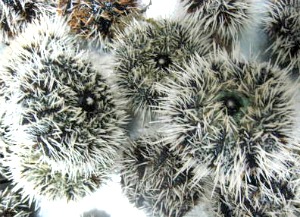 Sea urchins or urchins is an important shellfish resources in the Philippines. An obscure cousin of the starfish, it lives in shallow marine waters. Their shell, or “test”, is round and spiny, typically from 3 to 10 centimeters (1.2 to 3.9 in) across. Common colors include black and dull shades of green, olive, brown, purple, and red. They move slowly, feeding mostly on algae. The gonads or roe is the only edible part and is regarded in Japan as a delicacy called “uni”. In Southeast Asia and the US, the sea urchin is considered as an exotic food.
Sea urchins or urchins is an important shellfish resources in the Philippines. An obscure cousin of the starfish, it lives in shallow marine waters. Their shell, or “test”, is round and spiny, typically from 3 to 10 centimeters (1.2 to 3.9 in) across. Common colors include black and dull shades of green, olive, brown, purple, and red. They move slowly, feeding mostly on algae. The gonads or roe is the only edible part and is regarded in Japan as a delicacy called “uni”. In Southeast Asia and the US, the sea urchin is considered as an exotic food.
The name “urchin” is an old name for the round spiny hedgehogs that sea urchins resemble. Locally known as “maritangtang” in the Ilocos Region, “kuden kuden” in Bolinao and “tuyom” in the Visayas, the initial grow-out of sea urchins in sea pens begun in Sta. Maria, Ilocos Sur in 1998. In the same year, the community-based grow-out culture was promoted in Bolinao, Pangasinan. Several verification trials were also made in suitable areas of Ilocos Norte and La Union. Thereafter, innovations to improve culture methods had been adopted.
BFAR Region 01 has been vigorously promoting the cage culture of sea urchins for years now. Assessment of potential sites was undertaken, and demonstration cages were put up in coordination with Local Government Units (LGUs).
How to culture Sea Urchin in Cages:
PRODUCTION AND OPERATION
Assessment and Selection
Protected coves are essential sites for sea urchin farming with the following as additional technical considerations: existence of sea urchin stocks in the area; presence of sea grass beds; high water movement and tidal flushing; sheltered from storms and bad weather; no freshwater sources such as river mouths in the vicinity; sufficient depths (at least 1-1.5m deep at low tide) to prevent sea urchins from drying out and being exposed to freshwater in case of heavy rains; free from pollution; visible and accessible from the shore; and should not be within a navigational route.
Cage Construction and Installation
Cage dimension: 2.4m x 1.2m x 0.6m with polyethylene plastic screens and plain round bars as frames. The cages are installed at 0.3m above sea floor and 0.5m below water level during low tides. The cages are also set at 0.60m apart to ensure good water flow and prevent clogging from wastes and debris.
Modular System of Culture
The modular system of culture (7 cages/module) is recommended for sustainable production. In this system, Cage 1 is stocked with 2,000 pcs. of sea urchin juveniles (1-2cm test diameter or TD), After 2 months of nursery, the stocks are then transferred to Cages 2 and 3 at 1,000 pcs/cage. After another 2 months, the stocks from Cages 2 and 3 (3-4cm TD) are then transferred to Cages 4,5,6 and 7 at 500 pcs/cage. The stocks could then be harvested after another 2 months of culture or upon reaching 7-8cm TD.
Right after the stocks in Cage 1 are transferred, it could be restocked with small sized juveniles to start the second cycle.
Feeding and Management
Sea urchins are cultured for a period of approximately 6-7 months or until the stocks reaches 7-8cm TD. The stocks are fed with sargassum or aragan once or twice a week. Each cage is liberally stocked with fresh sargassum to ensure that they feed at maximum rates to ensure the growth and development of large gonads. The cages are also regularly cleaned of leftover algae or debris each time they are fed. Periodical checking of growth and survival of stocks should be undertaken.
Stripping an area of sargassum for feeding the caged sea urchins may result in the eventual denudation of the algae bed. To avoid this, do not harvest the sargassum by pulling them up from the seafloor together with their holdfast or “roots”. Use a small knife or sickle to selectively harvest only the plant’s secondary branches. Leave the roots and the primary axis intact, so that the plant is able to regenerate itself for future harvesting.
Harvesting and Marketing
Harvesting is done when the stocks reached 7-8cm TD. The modular system of culture ensure three cycles per year (harvest every two months). Sea urchins are sold fresh or processed (roe form) in the local markets or to direct buyers like big restaurants/and hotel operators.
The farming of sea urchin in cages addresses the need for resource sustainability and the recovery of natural stocks. It is a simple technology with minimal labor requirement and investment cost. It provides significant increase in income for fisherfolk.
Sources: BFAR R-01, trc.dost.gov.ph, en.wikipedia.org; Photo: okinawahostels.com